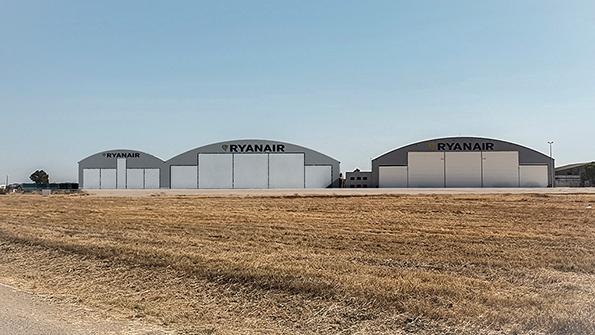
In an interview conducted in two parts, one shortly before the novel coronavirus pandemic and one in the middle of it, Ryanair Director of Maintenance and Engineering Karsten Muhlenfeld talks to Inside MRO’s James Pozzi about the low-cost carrier’s capacity plans and how it has adjusted maintenance operations given the COVID-19 crisis.
In late 2019, Ryanair sent some lines of maintenance outside Europe to Joramco in the Middle East. Was the decision to look beyond Europe for some maintenance requirements a capacity-driven one?
It wasn’t solely a capacity issue. We want to operate our capacity in our existing hangars, but if that is fully utilized, then we will naturally have to outsource work. In order to do that, we work with several companies in Europe or close to the continent. Joramco had shown itself to be very efficient and to deliver a very good MRO service; so we decided to try it as a provider. It’s the first year we have worked with Joramco. We sent two full scheduled lines of heavy maintenance, and we are happy with what it has delivered.
Joramco isn’t the only external supplier we are using, however—we have five other MRO providers undertaking checks for us. We are in a season with significant scheduled maintenance [March 2020], which is fixed, and because of the growth of the fleet at certain times, we have very specific requirements. That means working with external companies.
Ryanair has built up some impressive in-house capabilities on airframes, but is it looking to add more in areas such as parts repairs?
We do the major overhaul of the aircraft and for some parts—for example, an aircraft water boiler—we will repair them in-house at one of our workshops. But for complicated parts related to an aircraft’s electronics, we outsource to the OEM, and that won’t change. We feel that going to the OEM for these more specialized repairs is a good solution, as it guarantees we will receive an in-depth level of expertise and product knowledge.

What is the ratio of insourced to outsourced maintenance?
Currently it stands at around 80% of maintenance being done in-house, with the remainder of work outsourced to third parties.
November 2019 saw some issues related to pickle fork cracks on Boeing 737-800 aircraft, which led to three Ryanair-operated aircraft being grounded. Did this issue have a significant effect on your fleet operation?
Our mechanics identified a small number of findings on some aircraft that needed to be repaired and that was for Boeing to repair. From that point of view, it had no impact on us because it was only a small number of aircraft, and occurring during the winter season meant we had some spare aircraft available. Nearly all of our heavy fleet maintenance is done in the winter, so we could afford to send these aircraft to Boeing to be repaired and see no impact.
Given growing internal base maintenance requirements, how is Ryanair looking to address concerns about MRO capacity in its network?
Upon reviewing our heavy maintenance capacity across sites in Prestwick (UK) with five maintenance bays, Kaunas (Lithuania), Wroclaw (Poland) and Seville (each with two bays), we analyzed where it made sense to grow further and decided that we will expand the hangar in Seville by an additional two bays in 2021. We’re also growing capacity in Prestwick from five bays to six bays this year. We’ve already grown there significantly on the base maintenance side. We’ve also ramped up our line maintenance network and in the past year or so have added new lines at Milan Bergamo Airport.
Inside MRO spoke again to Karsten Muhlenfeld in May 2020 for an update on how the airline has adapted its maintenance operations in the wake of the COVID-19 outbreak.
Ryanair grounded its entire aircraft fleet after the novel coronavirus pandemic led to global travel restrictions. How has this affected your maintenance operations?
We have chosen to put aircraft in short-term storage or in active parking. The procedures are provided by Boeing and Airbus, and we have followed their instructions. The aircraft are flown regularly, which will allow us to resume operations quite fast once we are able to.
Where is Ryanair parking its aircraft?
We have parked the aircraft at our main bases (located throughout Europe) to ensure that we can perform maintenance efficiently.
What reductions or changes has Ryanair had to make to its maintenance teams due to COVID-19?
The COVID-19 pandemic has created an unprecedented crisis for the aviation industry. We are now facing a new environment of lower fares and distorted competition due to below-cost selling by inefficient airlines propped up by unlawful state aid. Unfortunately, all areas of the business have seen staff reductions in order to adjust to this new environment.
Ryanair Fact File
- History: Ryanair was founded in 1984 and commenced operations the following year. Under the leadership of Michael O’Leary, who joined Ryanair in 1987 before later becoming CEO, the airline has grown to be one of Europe’s largest and operates a route network across 40 countries in Europe, North Africa and the Middle East.
- Fleet: Before the grounding of its fleet, Ryanair operated 273 Boeing 737-800 aircraft. The wider group has nearly 200 more aircraft, with 120 737-800s operated by Malta Air and 26 Airbus A320-200s operated by Austrian low-cost carrier Lauda. Ryanair is also among the most high-profile customers for Boeing’s troubled 737 MAX program, with firm orders for 135 of the next-generation narrowbody in place and options on a further 75. The airline said earlier this year that the service entry of the MAX could be delayed by up to two years, but it remains committed to the program.
- Maintenance capabilities/locations: The airline has more than 70 line maintenance sites, with its four largest locations at London Stansted in the UK, Dublin, Milan Bergamo in Italy and Madrid. Its heavy maintenance operation includes four sites across Europe: Prestwick in Scotland, where it has six lines; Kaunas in Lithuania with two lines; Wroclaw in Poland with two lines; and Seville, Spain, which will expand from its current two lines to four lines by 2021.
- Maintenance staff: Pre-COVID-19, Ryanair had more than 2,000 engineers in total, comprising 1,100 in heavy maintenance, 800 in line maintenance and 200 staff in logistics, materials and continued airworthiness.



